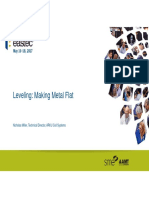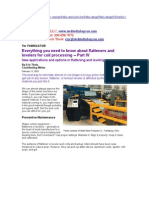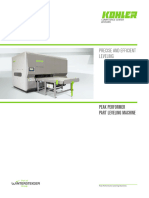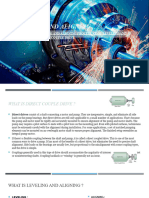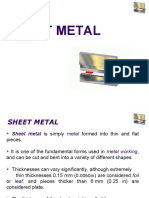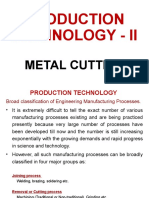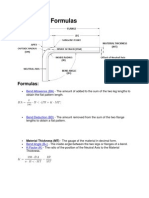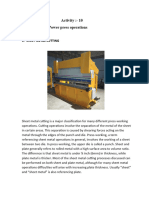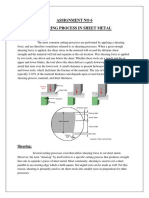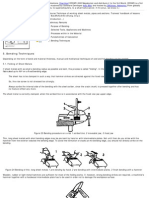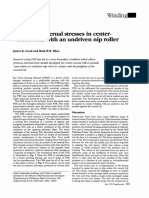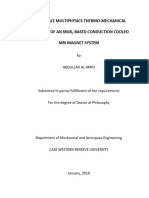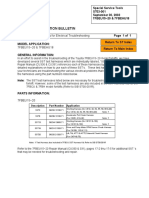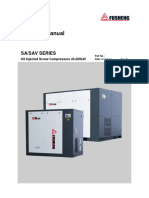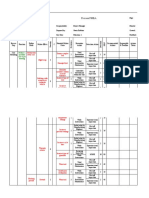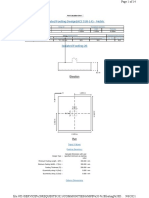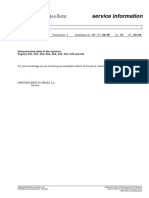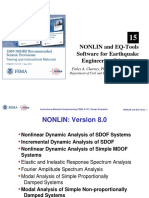Overview of leveling methods
Manual methods for leveling parts remain widespread in the sheet metal fabrication industry.
Depending on the type of company, manual techniques for part and sheet leveling are certainly
justified. However, many companies are simply not familiar with these methods and haven’t
researched alternatives. In this article, we will provide an overview of the various leveling
techniques and show how modern technologies have begun to change leveling for the better.
Flattening with a hammer and flame demands extensive expertise
Flattening parts with a hammer and flame may sound old-fashioned, but it still ranks among
the most used leveling techniques. Many companies process their sheet metal parts with this
manual method after punching, laser-cutting or plasma-cutting. Leveling with a hammer deals
with specific unflat areas. When using this approach, one lives with the fact that dents are flattened
in one location but may turn up again in another. That is why this manual leveling technique
demands qualified and experienced employees – and also time: working a sheet metal part with
a hammer can take anywhere from minutes to an hour.
The heating method, also known as flame leveling, is just as work intensive. Sections of the part
are heated with a flame and these points are then flattened by a hammer. A skilled leveling spe-
cialist uses this approach to shape the part into the desired (flat) form. Time should never play
a role here, because flame leveling is an art in itself. Training on this technique takes months,
if not years. Leveling a sheet metal part can also take hours, depending on the size of the part.
That is why the hammer and flame method is only used in industrial sheet metal fabrication for
very small quantities, or for pre-shaped parts.
Leveling with a press, only for small parts quantities
Leveling with a straightening press uses a die to press the part so that it contours into a flat
shape. Leveling with a press is best reserved for small quantities and isolated areas of uneven-
ness. Although the process might look easy, working with a press also demands experience.
Leveling a part with this method also takes time to achieve acceptable results. That is why
this method is only economical if only a few parts need to be leveled or small faults need to be
corrected.
www.arku.com 1
� Simple rolling machines only offer limited reliability
Employees at sheet metal fabricators need a lot of patience and skill when running a sheet
through a three-roll rolling machine. This process is time intensive because the sheets have to
run through the machine several times. These simple rolling machines are operated manually.
Because sheet metal fabricators often already have rolling machines, these are frequently still
used for bending parts flat. However, “re-purposing” the rolling machine for use as a leveler
can be risky, depending on the design and the machine environment.
In principle, simple roller levelers, also referred to as straighteners, can also consist of multiple
rolling machines arranged in a row. However, this simple roller leveling with up to 7 leveling
rollers is better suited for thicker parts and does not always deliver precise results. This is due
to the fact that rollers with a large diameter are often not supported and tend to yield beneath
the pressure of the part. Consequently, simple leveling machines only offer limited reliability and
are less suitable for leveling parts in series.
Level does not automatically mean stress-free
Manual or simple leveling methods flatten out uneven parts. But appearances can be deceiving.
Punching, laser-cutting or plasma-cutting create internal stresses in the material that are not
visible to the naked eye. These tensions result in uneven surfaces which only appear after further
processing the part. It often results in difficulties fitting the parts into the welding fixtures as well
as causing inconsistent welds. Especially during welding, these internal stresses materialize in
the form of visible flatness defects when applying heat to the parts with high internal stresses.
Employees then have to spend their valuable time reworking the pieces. In the worst case, the
sheet metal part may even become completely unusable.
Eliminate internal stresses with precision leveling machines
Today, customers demand flat parts free of internal stresses that can be processed to create
finished assemblies without any problems. If the client also requires increasing quantities,
unflat parts can result in bottlenecks and delivery problems. That is why many companies have
decided to purchase a precision leveling machine. Precision levelers are roller levelers with
special characteristics. Up to 21 leveling rollers are arranged in an offset pattern. The part
passes through an alternating bending process in which the bends become smaller and smaller
toward the end of the process. In comparison to simple roller levelers, precision levelers utilize
smaller diameter leveling rollers: These are arranged in a block configuration and are supported
by back-up rollers to prevent them from deflection. This creates enough rigidity to prevent the
rollers from yielding beneath the pressure of the part. Today, roller leveling with a precision
leveler should be the standard at every sheet metal fabricator.
www.arku.com 2
� Precision levelers work reliably and in seconds
Servo-hydraulic precision levelers provide state-of-the-art roller leveling. Punched, laser-cut
or plasma-cut parts and sheets are flattened and internal stresses removed in only a matter of
seconds. Sheet metal fabricators report that their processes have become more reliable and the
quality of the parts has improved. Using traditional methods, companies can often only level a
small portion of the job due to the extensive work or precision required. Using servo-hydraulic
precision levelers such as the FlatMaster from ARKU makes it economical to run all of the parts
through the machine. The flexibility of the hydraulic leveling gap control makes this possible.
This technology can handle a very broad spectrum of sheet metal parts. The machine also com-
pensates automatically for different cross sections on a single part and levels the parts or sheets
optimally. In comparison to traditional methods such as simple roller leveling or leveling with a
straightening press, which require highly trained personnel, smart technology makes operating
the precision levelers relatively easy. The machine will even suggest leveling parameters based
on algorithms. As a result, leveling with precision levelers does not necessarily require specialized
personnel. An employee can learn to use the machine in only a matter of hours.
Summary
If only a few parts need to be leveled, a press brake or similar equipment can still be used.
However, the leveling results with manual methods are not always reliable. Purchasing a
precision leveler is an effective solution for companies that have to process large quantities.
It requires fewer highly specialized personnel and also levels a large number of parts and sheets
quickly, reliably and with high quality. Contract leveling can also be a highly attractive alternative
for smaller or mid-sized quantities.
Individual results often vary, so ARKU offers new customers vouchers for free leveling trials.
www.arku.com 3

